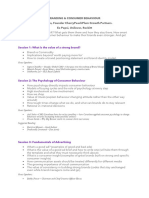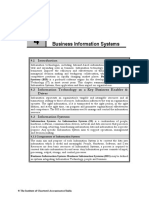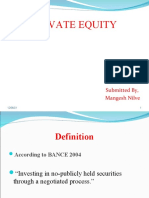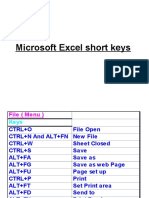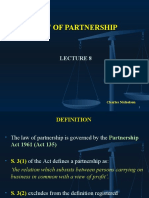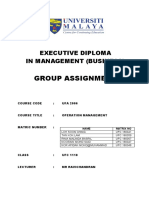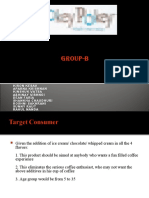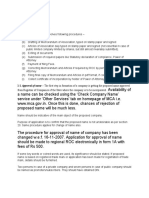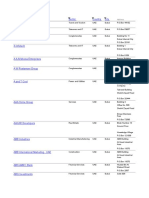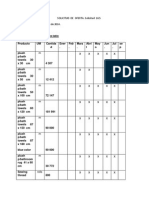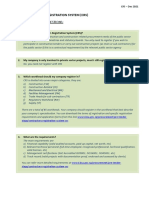Nestle Marketing Strategies
Nestle Marketing Strategies
Uploaded by
Brave Ali KhatriCopyright:
Available Formats
Nestle Marketing Strategies
Nestle Marketing Strategies
Uploaded by
Brave Ali KhatriCopyright
Available Formats
Share this document
Did you find this document useful?
Is this content inappropriate?
Copyright:
Available Formats
Nestle Marketing Strategies
Nestle Marketing Strategies
Uploaded by
Brave Ali KhatriCopyright:
Available Formats
Assignment Topic:
"Marketing Management Strategies of Nestlé"
By:
Muhammad Khubaib ul Aziz
Nadeem Ali
Muhammad Abid
Talib Hussain
MBA (2nd Semester)
TO
Mr. Farhan Aslam
Dept. of Management Sciences.
University of Agriculture Faisalabad.
Nestlé PURE LIFE DRINKING WATER
Nestlé Introduction:
Nestlé Worldwide
All over the planet, people know Nestlé. It’s the world’s largest food company, and among the world's 40 largest
corporations. To bring you the best products each and every day, we operate over 500 factories in 83 countries and
employ over 230,000 people. We’re truly international.
In spite of our global reach, what makes Nestlé special is that each of our national companies has the flexibility to make
their own decisions – in order to best meet the needs of their own people and communities.
Each region can choose to sell the brands that satisfy their own consumers’ unique needs. And yet, as part of the larger
organization, all benefit from access to global resources, decades of experience and our large chain of research and
development centres.
Today, Nestle is the world leading Food Company. Nestle headquarters is in Switzerland. Its international
R&D network supports the products made in more than 500 factories in 86 countries. The Nestle factories are operating
in the region of:
1. Africa
2. America
3. Asia
4. Europe
5. Oceania
Being a company dedicated to food from the beginning, Nestle remains sensitive to culinary and eating
habits, and responds to specific nutritional problems, whilst also setting and matching new trends such as growing out-
of-home consumption and caring about the well being of its consumers.
Nestlé Philosophy
Good Food, Good Life is the very essence of Nestlé and this philosophy can be traced back to our beginnings.
About us
Nestlé is the world's leading Nutrition, Health and Wellness company. We are committed to increasing the nutritional
value of our products while improving the taste. We achieve this through our brands and with initiatives like the
Nutritional Compass and 60/40+.
Nestlé PURE LIFE DRINKING WATER
How did Nestlé begin?
Peter Brabeck-Letmathe: A hundred and thirty years ago, infant mortality was high in Switzerland—
higher than in most emerging countries today. Henri Nestlé was a pharmacist who was worried about
children dying. He developed an infant cereal to help feed them. This was the first Nestlé product.
Henri Nestlé had two big visions. First, he immediately went international: the product was in five
European countries four months after launch. Second, he wanted his own brand. Store brands—private
labels—already existed, but he was one of the first to create a manufacturer's brand.
Branding
Brand Meaning & Brand image:
Henri Nestlé endowed his company with the symbol derived from his name. His family coat of arms, the
nest with a mother bird protecting her young, became the Company's logo and a symbol of the Company's care
and attitude to life-long nutrition. The Nestlé nest represents the nourishment, security and sense of family that
are so essential to life.
He also established a strong identity for his company through the nest image that Nestlé still uses
today. It happens that Nestlé in Germany means "little nest," symbolizing all the good
values of nurturing such as family, warmth, and caring. When distributors asked him why he
did not put the Swiss flag on his product, he is said to have replied, "Anyone can use the Swiss flag, but
only I can use my coat of arms. It will be my seal of quality." His house and first factories were in Vevey,
Nestlé's headquarters.
BRIEF HISTORY OF NESTLE:
1866-1905
In the 1860s Henri Nestlé, a pharmacist, developed a food for babies who were unable to breastfeed. His first success
was a premature infant who could not tolerate his mother's milk or any of the usual substitutes. People quickly
recognized the value of the new product, after Nestlé's new formula saved the child's life, and soon, Farine Lactée Henri
Nestlé was being sold in much of Europe.
Nestlé PURE LIFE DRINKING WATER
1905-1918 (Merger with the Anglo-Swiss)
In 1905 Nestlé merged with the Anglo-Swiss Condensed Milk Company. By the early 1900s, the company was operating
factories in the United States, Britain, Germany and Spain. World War I created new demand for dairy products in the
form of government contracts. By the end of the war, Nestlé's production had more than doubled.
1918-1938 (Line expansion)
After the war Government contracts dried up and consumers switched back to fresh milk. However, Nestlé's
management responded quickly, streamlining operations and reducing debt. The 1920s saw Nestlé's first expansion into
new products, with chocolate the Company's second most important activity
1938-1944 (Decline)
Nestlé felt the effects of World War II immediately. Profits dropped from $20 million in 1938 to $6 million in 1939.
Factories were established in developing countries, particularly Latin America. Ironically, the war helped with the
introduction of the Company's newest product, Nescafé, which was a staple drink of the US military. Nestlé's production
and sales rose in the wartime economy.
1944-1975 (Growth) & (Diversification & mergers)
The end of World War II was the beginning of a dynamic phase for Nestlé. Growth accelerated and companies were
acquired. In 1947 came the merger with Maggi seasonings and soups. Crosse & Blackwell followed in 1960, as did Findus
(1963), Libby's (1971) and Stouffer's (1973). Diversification came with a shareholding in L'Oréal in 1974.
1975-1981 (Maturity) & (venture)
Nestlé's growth in the developing world partially offset a slowdown in the Company's traditional markets.
Nestlé made its second venture outside the food industry by acquiring Alcon Laboratories
Inc..
1981-1995 (Market Revitalization Strategy)
Under a new Chief Executive Officer, Helmut Maucher, Nestlé approached the 1980s
with a renewed flexibility and determination to evolve. The Company's strategy for this
period was twofold: improve its financial situation through internal adjustments
and divestments, and continue its policy of strategic acquisitions.
Thus, between 1980 and 1984, the Company divested a number of non-strategic or
unprofitable businesses.
Nestlé divested a number of businesses1980 / 1984. In 1984, Nestlé's improved bottom line allowed the Company to
launch a new round of acquisitions, the most important being American food giant Carnation.
Nestlé PURE LIFE DRINKING WATER
1996-2002 (merger into Dreyer's & USD 2.6bn acquisition of Chef America, Inc)
The first half of the 1990s proved to be favorable for Nestlé: trade barriers crumbled and world markets developed into
more or less integrated trading areas. Since 1996 there have been acquisitions including San Pellegrino (1997), Spillers
Petfoods (1998) and Ralston Purina (2002). There were two major acquisitions in North America, both in 2002: in July,
Nestlé merged its U.S. ice cream business into Dreyer's, and in August, a USD 2.6bn acquisition was announced of Chef
America, Inc.
2003 + (market leader by acquiring Mövenpick & got#2 position in healthcare nutriton)
The year 2003 started well with the acquisition of Mövenpick Ice Cream, enhancing Nestlé's position as one of the world
market leaders in this product category. In 2006, Jenny Craig and Uncle Toby's were added to the portfolio..
Nestlé made three significant acquisitions in 2007. The first was Novartis Medical
Nutrition which put Nestlé in a strong number two position globally for healthcare
nutrition. Gerber, the iconic US baby food brand was the second acquisition and the third
was the Swiss water company, Sources Minérales Henniez S.A. The end of 2007 was
marked by a strategic partnership with the Brussels-based luxury chocolate maker Pierre Marcolini. The move
underlines Nestlé's commitment to excel in the premium and luxury chocolate market. Marcolini was represented in
September 2009, when Nestlé opened the Chocolate Centre of Excellence in Broc, Switzerland, a strong support for the
premium sector.
Nestlé Water: Key dates in history
1843: Henri Nestlé establishes his first lemonade and water bottling factory.
1969: Acquisition of a 30% stake in the Société Générale des Eaux Minérales de Vittel Société Générale des
Eaux Minérales de Vittel
1974: Acquisition of the German Blaue Quellen group.
1987: Nestlé S.A. takes a majority stake in Vittel.
1992: Acquisition of the Source Perrier S.A. Source Perrier SA
1996: NSI changes its name to accelerate its international development and becomes: Perrier Vittel S.A.
Nestlé PURE LIFE DRINKING WATER
1998:
Take-over of Italy’s leading bottled water producer, Sanpellegrino S.p.A Sanpellegrino S.p.A
Launch of Nestlé Pure Life, the first multi-site bottled water under the Nestlé brand.
2000: Simultaneous launch of Nestlé Aquarel, pan-European, multi-site spring water on six markets.
2002: Perrier Vittel becomes Nestlé Waters.
2003: Nestlé Waters celebrates its tenth anniversary and acquires Europe's leading HOD company, the Powwow
Group.
2004: Nestlé Waters expands its business activity in Asia (in South Korea and Indonesia) through external
growth.
2005: Nestlé Waters further develops its business on the African continent via the launch of Nestlé Pure Life in
Nigeria and the creation of a partnership in Algeria.
2006: Nestlé Pure Life becomes the Group's leading brand.
2007: Nestlé Waters acquires Sources Minérales Henniez S.A. and becomes the Swiss leader in the bottled
water market.
2008:
Joint venture agreements signed in Mexico and Chile.
NESTLÉ PURE LIFE , has become in just a decade the world's leading bottled water brand, with 5 billion
litres sold worldwide.
MISSION STATEMENT
“Nestle is dedicated to providing the best foods to people throughout their day,
throughout their lives, throughout the world. With our unique experience of
anticipating consumers' needs and
Creating solutions, Nestle contributes to your well-being and enhances your
quality of life.”
Nestlé PURE LIFE DRINKING WATER
HOW NESTLE DEFINE MARKETING:
Building customer relationship based on customer value and satisfaction is at the very heart of modern marketing. The
two fold goals of Nestle marketing is to attract new customers by providing superior value and to keep and grow the
current customers by delivering satisfaction. Nestle defines marketing as:
“A social and managerial process where by individual & groups obtains good food
and good life through creating and exchanging products and values .”
MARKETING PHILOSPHY NESTLE ADOPTED:
Nestle vision is to be the leading food & beverage company in the world providing customers with healthy food at
affordable prices. Their logo is Good Food for GOOD LIFE; there all products are for society welfare. So according to their
logo and mission statement it is very fair to say that they are following the
Societal Marketing Concept.
PRODUCT MIX OF NESTLE
International Brands:
Product Lines
Bottled Baby Breakfas Cereals Chocolate & Coffee Dairy Drinks Ice Nutrition Petcare
Water Foods t Confectioner products Cream & Health
y
Arrowhead
Deer Park
Perrier
Poland
Spring
Pure Life
S.Pellegrino
Nestle is a well-known company all over the world and Pakistan. The company basically deals in food products as
their logo says “Good Food, Good Life.” Their major products lines are:
Milk Products:-
i) Nestle Milkpak UHT Milk:
Nestlé PURE LIFE DRINKING WATER
This product was launched in 1981. Backed by a very strong brand name, aggressive marketing and distribution
plan, consistent quality, and availability throughout the year, it has become quality milk. In September 1999, Milk Pak
UHT milk was launched as Nestle Milk Pak UHT milk. It is available in 1000, 500 and 250 ml sizes.
ii) Milkpak Butter:
This product was launched in 1985 under the Milk Pak brand name. It has been recently repackaged in a crisp
white laminate, the design of which bears closed resemblance to that of Milkpak UHT milk. This new package design
allows to gain strength from Nestle Milkpak UHT milk. It is available in 200 and 100 gm sizes.
iii) Milkpak UHT Cream:
This product was launched in 1986 under Milkpak brand name. It is available in 200 ml size.
iv) Milkpak Desi Ghee:
. This product was launched in 1986. It is available in 1000 ml size and is a leading branded desi ghee in the
country.
v) Nestle Everyday:
To meet the requirements of the tea-whitening segment, this product was launched in 1992. On account of
aggressive marketing, focused distribution, excellent consumer acceptance and product quality, this brand has shown
strong growth and holds good promise for the future.
vi) Nestle Nido:
Soon after it was introduced in the early 70`s as an imported product, Nido full cream milk powder became the market
leader. Local manufacturing of Nido began in 1990, which has reinforced its position as the dominant player in the full
cream milk powder category.
II- Chocolate Drinks:-
i) Milopowder:
This product was launched in 1994. It is available in 14,100 and 200 gm sizes. It is strongly associated with a healthy
life style and is an ideal drink for growing children who need strength and energy.
ii) Milo RTD:
To cater for consumer convenience, Milo RTD (ready to drink) was launched in 1995 and is now available in an
attractive 180 ml slim pack. It is popular among all age groups especially among the growing segment of nutrition
conscious consumers. It is an excellent substitute for cold drinks.
III- Coffee:-
i) Nescafe Classic:
It is one of the world’s most popular coffee brands. Nescafe global campaign “open up” was launched in Pakistan in
October, introducing a new brand framework and increased emphasis behind coffee sales in Pakistan. Nestle
Milkpak locally packs imported coffee and markets it in 225 and 500gm.
IV- Fruit Drinks:-
i) Frost:
It is a well-known brand launched in 1986 and has the largest market share. Positioned as a cold drink and an
alternate to cola drinks, its strength lies in the convenience attached to its usage.
ii) Nestle Orange Juice:
The product was launched in July 1996. It is available in 180ml and1litre sizes. In a market that is becoming increasingly
conscious about nutrition and is displaying preference for healthy drinks, Nestle Orange Juice has made very good
inroads and has a strong potential in the future.
V- Dietetic & Infant Products:-
Nestlé PURE LIFE DRINKING WATER
i) Lactogen:
Lactogen 1 and Lactogen 2 are infant and follow-up formulae launched in 1991 and are available in two sizes both pack
and can. The brands provide both affordability and quality.
ii) Cereals:
Launched in 1989, it is the dominant player in the growing infant food market. It is available in 5 flavors and provides
balanced nutrition to infants.
iii) Nestle Rice:
An affordable starter weaning cereal and offers the flexibility of preparation with a variety of meals. This was
launched in 1994 and available in125ml pack size.
iv) Nestle Wheat:
Nestle wheat is a wheat-based infant cereal without milk. It is available in 125 and 200 gm pack sizes.
iv) Neslac:
Neslac is a growing up milk, formulated specially for 1 to 4 years old. This was launched in 1994. It contains a right
balance of proteins, calcium, iron, vitamins and essential minerals in order to cater nutritional needs of growing
children.
VI-Culinary Products:-
i) Maggi 2-minute Noodles:
Fast to cook, good to eat – Maggi 2-Minutes Noodles were launched with local production in 1992, and doing so
Nestle pioneered the category of instant noodles in Pakistan. It offers flavors like chicken masala, chili and
chatkhara.
ii) Maggi Cold Sauces:
Nestle entered the Cold Sauces category early in the year with the launch of Maggi ketchup, Maggi mirch maza and
Maggi khatti meethi – the first Emily sauces in Pakistan. The innovative taste of Khatti meethi together with the
more traditional tastes of Ketchup and Mirch maza, were received well by the consumers.
VII- Confectionery:-
In view of the impressive potential for confectionery sales in the country, Nestle Milkpak established an independent
sales and distribution network for confectionery products. From three main cities in 1996, it has grown into a nation-
wide network. The initial product range includes locally produced Polo Mint, Kitkat, Smarties, Lion Bar, and Fox’s, Allen’s
Toffo and Allen’s Soothers. Both Toffo and Soothers are produced on a new confectionery line-based on a new state-of-
the-art technology that provides an extremely flexible process for production of wide range of high and low boiled
candies. This will enable the company to introduce varieties of new sweet flavors over the next few years.
VIII- Water:-
Nestle Pure Life:
Nestlé PURE LIFE DRINKING WATER
The launch of Nestle Pure Life in December 1998 was a truly historic event. This marks the Nestle Pure Life’s entry
into the country’s fast growing water market. At the same time Pakistan became the first country where Nestle
launched the new brand. Nestle Pure Life is a premium drinking water, produced to the highest standards of safety
and purity. It is ideally balanced with essential minerals. It is available in two convenient sizes of 0.5 and 1.0 liters.
Capitalizing on its strong brand recognition, aggressive pricing and supported by a strong marketing campaign,
Nestle Pure Life has made very strong inroads into the water market in Pakistan. Nestlé PURE LIFE is available
around the globe today in Canada, USA, Mexico, Brazil, Argentina, South Africa, Saudi Arabia, Jordan, Egypt,
Lebanon, Turkey, Russia, Uzbekistan, Pakistan, China, Thailand, and the Philippines. Launched on the North
American market in 2003, Nestlé PURE LIFE is destined to become the world’s leading and most widely distributed
brand by 2010.
MARKETING PHILOSPHY FOR NESTLE PURE LIFE WATER:
Nestle Pure Life is a premium drinking water, produced to the highest standard of safety and purity. Their aim is to
provide customer with pure drinking water on suitable prices make the product as convenient as possible. According to
their claim that they provide the best food through out the world. For Nestle Pure Life they adopted the societal and
marketing concept.
STRATEGIC PLANNING:
BCG MATRIX FOR THE SBU’S:
Nestlé PURE LIFE DRINKING WATER
Pure Life
Confectionaries
Milk Products
Coffee
Dietetic & Infant Chocolate
foods Drinks
Fruit Drinks
STARS: The two Sbu’s, Mineral water and Confectioneries fall into this category of the BCG. These SBU’s have high
market share and high industry growth rate. These Sub’s are requiring lots of investment to compete in the growing
market. For example, lots of money is being spent and aggressive marketing strategies have been implemented for the
Mineral water to build and maintain market share. Nestle Pure Life has captured 50 % of the bottled-water market in
Pakistan since it was introduced in 1998. Its approximate sales for 1999 are RS. 70, 401000. This sales figure is quite
impressive as the sales rose quite high in only one year. The sales of the confectioneries rose to RS. 106,559 000 from
RS. 87,758 000. The huge increase of RS. 18, 801 000 puts this SBU in the stars category and shows its increasing market
share. There is a growing market for the products in confectioneries for example Kitkat (eventhough it’s imported), Polo
Smarties etc. This can be proven from the fact that Nestle keeps introducing new products in this category for example
Allen’s Soothers were launched during the last quarter of 1998.
CASHCOWS: Milk products, Coffee and Dietetic and Infant food have a high market share and are doing business in
mature industries. Since the customers of this product category are loyal, the marketing costs of these SBU’s is quite
low and as a result a large amount of cash can be generated. Customer Loyalty is a must for these Cashcows to maintain
their market share. The sales of the Milk products have increased to RS. 108,430000 from RS. 87,758000. This huge
increase in sales reflects the high market share of this SBU. However, its growth rate is low because in general this
category is in its maturity stage – that is – a number of milk products have been launched by Nestle, most of which are
quite old. An innovation has not really been made in this category. The same conclusion can be made about Coffee.
There is an already existing market for Coffee which is not increasing further by a large amount. The sales of Coffee
were Rs. 46,89 000 in 1999 and Rs. 392,00 000 in 1998. This huge difference shows that a great amount of cash is being
generated from this SBU. Sales of Dietetic and Infant food rose to Rs. 60,935 000 from Rs. 52,655 000.
Nestlé PURE LIFE DRINKING WATER
QUESTION MARKS: Included in this section is the culinary products of the organization. The products such as Maggi 2-
minute Noodles and Maggi cold sauces have a low market share and a high growth rate. These products especially the
cold sauces are operating in a highly competitive market. The approximate sales were Rs. 79,919 000 in 1999 and Rs.
60,818 000 in 1998. This figure represents a great potential for growth in future. However, in contrast, the market
share of the products in this category is not very high currently. A reason for this is that Nestle just recently introduced
cold sauces such as “Emily sauce” etc.
DOGS: Chocolate and Fruit drinks fall into this category and they possess a low market share and a low growth rate.
Chocolate drinks had sales of Rs. 19639000 in 1999, which rose from Rs. 19541000 in 1998. This is quite a small increase
considering the rise in the sales of other SBU’s. However, the chocolate drinks are still profitable so the firm does not
have to worry about liquidating or getting rid of this SBU. The sales of Fruit drinks rose to Rs. 40,620 000 in 1999 from
Rs. 38,103 000 in 1998.
Objectives of Nestle Pure Life:
The main objective for the SBU was to be number one selling bottled-mineral water in Pakistan. This objective was
hoped to be accomplished by setting the following further sub-objectives.
i) Safety: To provide the consumers with a safe drinking water: Consumers want reassurance. The Nestle name on the
product is an assurance of quality for the consumer. Also related to safety is the fact that the water is captured in a
safety environment and undergoes rigorous treatment to meet universal quality standards. The water is de-mineralized
by distillation. Mineral salts are then added, in accordance with a strict formula developed. The bottling line is also
subject to strict sanitary regulations: an air-controlled room houses the filing machine, and the bottles and caps are
sterilized. Quality is a continual process and is monitored during each production phase - some 200 controls. Packaging
also receives special attention. Each Nestle Pure Life bottle and the 5-litre PET jug have a special cap and tamper-
resistant band. This way, the consumer can tell immediately whether the bottle has come straight from the plant or if it
has been tampered with.
2. To offer consumers a healthy product:
Remineralization let Nestle offer consumers a balanced, refreshing and healthy product, the product's second key
objective. The formula developed for Nestle Pure Life contains minerals such as calcium, which is essential for bone
development; magnesium, which is recommended for muscles and the central nervous system; bicarbonates, which are
particularly useful for digestion; and sodium, which helps regulate hydration in the human body. Overall mineralization
is light (200 mg per liter) and suitable for the whole family.
iii) To offer an affordable mineral water: As well as being pure, safe, healthy water, Nestle Pure Life is affordable and
convenient. No matter what the format, Nestle Pure Life is sold consistently at popular prices affordable for a large
portion of the population. The 1.5-L bottle is offered for Rs. 22 -- cheaper than most of the other water brands of the
same size. The 0.5 L bottle was initially offered for Rs. 8 but now is sold for Rs. 12. The increase in price has been caused
mainly due to inflation and competition.
iv) To make the product as convenient as possible: This was the product's fourth objective. Due to its well-balanced
mineral content, Nestle Pure Life can also be used for cooking and to prepare tea or coffee. The brand is available in
several formats suited to a variety of consumption patterns (50 cl, 1.5 litre, 5 litre). The idea is clear: to be close to the
Nestlé PURE LIFE DRINKING WATER
consumer. In other words, Nestle Pure Life must be available in all sales and restaurants outlets and anywhere else
consumers young and old are likely to buy or drink water.
These objectives can be very well matched with the mission statement of the organization. Consider the following
mission statement:
“Nestle is dedicated to providing the best foods to people throughout their day, throughout their lives, throughout the
world. With our unique experience of anticipating consumers' needs and
Creating solutions, Nestle contributes to your well-being and enhances your quality of life.”
NESTLE PURE LIFE & ITS COMPETITORS:
There are not too much competitors of nestle pure life in the market because Nestle was the only company who gives
the idea o bottled water. Up to some extent Atlantis, Sufi, and AVA are the competitors of Pure Life Water. Pepsi and
Coca Cola will be their competitors because they are also marketing their drinking water Aquafina by Pepsi & Kinley by
Coke backed by their parent Brand images.
Competitor Analysis (in Pakistan):
Competitors Analysis
Brands TOTAL SHARE
NESTLE 2903040
•
Aquafina 1995849
•
Sufi 453600
•
Kinley 1451520
•
Other 2268000
•
TOTAL SHARE 9072000
•
Key Figures (Nestlé):
Key Facts and Figures (Water)
Sales Organic CEBIT RIG Employees Production Producing Brands
growth facilities countries
9061 M -1,4 % 632.2 M -1,5 % 30 260 97 36 64
CHF CHF
5996 M 418 M €
€
Nestlé PURE LIFE DRINKING WATER
* Based on the global market in value including the HOD segment, Zenith International estimates,
CEBIT : Consolidated Earnings Before Interest and Tax
RIG : Real Internal Growth
CHF : Swiss Franc
Key Positions 2009 in value :
N # 1 bottled water company worldwide
N # 1 in North America
Canada, United States of America
N # 1 in Europe
N # 1 Belgium, France, Hungary, Italy, Switzerland
N # 2 Germany, Poland, United Kingdom
N # 3 Russia, Spain
N # 1 Latin America
N # 1 Cuba
N # 2 Argentina
Africa & Middle East
N # 1 Bahrain, Egypt, Jordan, Lebanon, Qatar, Saudi Arabia, Turkey, Uzbekistan
N # 2 South Africa
Asia
N # 1 Pakistan, Vietnam
N # 2 Thailand
N # 3 South Korea
Brand Asset Valuator:(Nestlé Pure Water is Market Leader)
Differentiation & Energy
Niche E R E K
Cu Cu Cu Cu
Leading
Declining
New
Eroded
Unfocused
Relevance, Esteem & Knowledge
Nestlé PURE LIFE DRINKING WATER
Breakdown by Breakdown by Breakdown by
geographic zone (in%) ditribution channel (in%) brand in %
En Packaging Water
ergy -24% -38%
-22%
Nestlé Waters has reduced energy Nestlé Waters has reduced With 0.675 L
consumption per litre produced by packaging weight per litre additional water used
22% in its factories between 2004 produced by 24% between to produce one liter
and 2009 2004 and 2009 in 2009, Nestlé
Waters has reduced
its water use ratio by
38% in its factories
since 2009
MARKET SHARE OF PURE LIFE WATER:
The Percentage Use of Nestle Pure Life and its Nestle occupied 85% of drinking water market in all over the
Competitors in Islamabad
Pakistan. In Lahore Nestle Pure Life has 69%of total market, Sparklet
has 13% and Cool have 11% and reaming 7%are kept by other local
companies. In Karachi 50% of market is kept by Nestle and 25% by
AVA and remaining 25% is kept by other local companies. As for as
Islamabad is concern Nestle Pure Life has 65%of market
Others Share.
18%
Nestlé PURE LIFE DRINKING WATER
Market Share of Nestle Pure Life in Market Share of Nestle Pure Life in Karachi
lahore
1
1
2 2
3
3
4
STRATEGIES FOR COMPETITIVE ADVANTAGES:
Every product on the shelf, every service and every customer contact helps to shape this image. A Nestlé brand
name on a product is a promise to the customer that it is safe to consume, that it complies with all regulations and that
it meets high standards of quality. Customers expect us to keep this promise every time.Under no circumstances will we
compromise on the safety of a product and every effort must be made to avoid hazards to health. Likewise, compliance
with all relevant laws and regulations is a must and is not negotiable. People, equipment and instruments are made
available to ensure safety and conformity of Nestlé products at all times. The effort is worth it. Companies with huge
quality standards make fewer mistakes, waste less time and money and are more productive. They also make higher
profits. Quality is our most successful product. It is the key to our success, today and tomorrow.
The customer comes first
We want to win and keep customers: distributors, supermarkets, hotels, shopkeepers and the final consumers.
They have very different requirements. Trade customers expect excellent service, correct information and timely
delivery. Consumers consider taste, appearance and price when they make their choice. Our task is to understand what
customers want and respond to their expectations rapidly and effectively. We serve various groups of consumers and
there is demand for products at different levels of perceived quality and price. All customers, however, expect value for
their money – good quality at a reasonable price. When offering quality to customers we also mean environmental
quality. Nestlé shares society’s concern for the environment and is committed to environmentally sound business
practices throughout the world.
Customers are central to our business and we must always respect their needs and preferences.
Quality is a competitive advantage
We live in a competitive world and must never forget that our customers have a choice. If they are not satisfied
with a Nestlé product, they will switch to another brand. Our goal, therefore, is to provide superior value in every
product category and market sector in which we compete.
The pursuit of highest quality at any price is no guarantee for success, nor is a single-minded cost-cutting approach.
Lasting competitive advantage is gained from a balanced search for optimal value to customers, by simultaneous
improvement of quality and reduction cost.
Nestlé PURE LIFE DRINKING WATER
Success can never be taken for granted. We must watch and learn from our competitors. If they do something better, we
must improve our own performance. We can achieve competitive advantage through Quality.
Quality is a joint effort
Operating companies are fully responsible for maintaining agreed quality standards. Not only Production units,
but also Marketing, Purchasing, Distribution and Sales have a vital role to play in providing quality to customers. This
implies a thorough knowledge of the products and services we offer
Quality units at different levels of the organization provide specific support, promote quality awareness, assume
guardianship and audit the system. Quality departments monitor operations against agreed standards and must
intervene in case of non-conformity.
Quality is made by people
Adequate equipment, procedures and systems are needed to make Quality; so are involved and dedicated people. Each
and every Nestlé employee must do his best to provide quality products and services.
Training and teamwork are crucial to the successful implementation of high quality standards. Continuous training
ensures that everyone understands his tasks and has the necessary skills to carry them out. Teamwork allows us to
achieve results that are greater than the sum of individual efforts.
We motivate employees by demonstrating management commitment to Quality, by setting challenging goals and by
giving them responsibility and recognition. It is through employee involvement that goals and targets can be achieved in
the shortest time. Quality must be a way of life for everyone in the company.
Quality is action
Quality is the result of deliberate action. It is the responsibility of senior managers to communicate the quality objectives
and to provide the resources necessary for their implementation. It is then up to all employees to make Quality happen
throughout the company. Progress is followed by listening to our customers and by measuring our performance.
Shortcomings and mistakes must be analyzed and corrected. Problems must be anticipated and prevented before they
occur. We also must identify and take advantage of opportunities.
To stand still is to fall behind. So we must strive for continuous improvement in every area. It is through many small
improvements as well as through major breakthroughs that we will achieve excellence.
SALES STRATEGY OF NESTLE PURE LIFE WATER:
The sales strategy which Nestle adopted for Pure Life water is Availability & Visibility. To increase sales and gain profit
the company has to provide proper supply of product in the market. All the time company remains busy to make the
availability of their product in the market. In departmental stores and shops the Pure Life Water is so placed that it is
visible for the customers.
SALES PROMOTION STRATEGY:
Nestlé PURE LIFE DRINKING WATER
Personal Selling: A direct Vendor Selling Activity was coordinated and carried out during the summer months
of June, July, and August 1999 in Lahore. A team of vendors, clad in branded T-shirts, caps and jackets, sold
chilled 0.5 liter bottles to travelling customers on all major intersections. The brand got great mileage out of
this innovative idea of personal selling in terms of brand awareness, paid trial, image as well as real sales.
Publicity: Nestle Pure Life was launched on 14 December, 1998 in Karachi with a huge amount of enthusiasm
and positive response shown by the locals. The successful story of its launch was printed in all the local
newspapers the next day. This greatly helped in creating awareness of the brand and gave its introduction a
good start.
Sales Promotion: Specific promotions of Nestle Pure Life were arranged in some of the key outlets of Lahore.
Elaborate shelf space was acquired for product display and specially designed POS material was extensively
used to promote sales. On a 12-bottle purchase of 1.5 ml, one 1.5 ml bottle was offered free to consumers.
Similarly on a 6-bottle purchase of 1.5 ml, one 0.5 ml bottle was offered free. Regarding trade promotion, the
retailer was also given an additional discount of 4 % during this sales promotion. Not only did the sales of
Nestle Pure Life grow tremendously during the promotion, these continued at a higher pace even after it was
over.
Product sampling and sticker sampling activities were carried out in Murree in summer of 1999. Nestle
marketing team has also undertaken a major education campaign on water use and its importance in daily life. Mothers
of school children were sent an invitation to attend a Water Show demonstrating the benefits of safe water and were
asked to fill out a questionnaire. The questionnaire refined the team's knowledge of consumer perceptions. At the end
of the show, visitors received a promotional kit offering a chance to sample Nestle Pure Life and opportunity to enter a
photo contest on the theme “Nestle Pure Life and You.” The contest offered 10,000 rupees in prize money. This helped
boost the brand's image in the minds of consumers. Another contest took place in October 2001by the name of
“Cricket Hangama.” This contest provided a chance to win a thousand of tickets, signature posters, VIP Tickets, and a
chance to dine with the cricket stars.
Nestlé PURE LIFE DRINKING WATER
Nestlé Pakistan's supply chain makes sure that Nestlé products are available, no matter where you are in Pakistan.
We integrate processes from the farm to markets, and ensure products are delivered to you at the right time, the right
cost and in the right quantities. In the first quarter of 2006 alone, we delivered an astonishing 136 million kg of Nestlé
products in Pakistan.
Supply chain was established as a separate department in 2001. Since then, we've achieved a number of milestones,
including a cold-chain in 2002, centralized demand and supply planning in 2003, and implementation of GLOBE in 2005.
We were selected for a Best in Class repository study, and three of our best practices were subsequently incorporated
into the Best Practices Library.
Our mission is to:
• Optimize and consolidate resources and processes for a low- cost but efficient
• Develop and manage simplified and effective supply network to achieve a high level of service
• Create a continuous improvement culture driven by performance measures and reward
Public Relations:
As far as the public relations is concerned, The organization releases an annual report which includes the company's
financial statements along with the sales of all product categories. The annual report is mainly aimed at the
stockholders. However, another very important form of public relations are the newsletters and bi-monthly magazines
issued by the organization. A huge amount of information is found in these regarding the products and their promotion.
In the same way, Nestle Pure Life was given quit a bit of importance in the newsletters issued after its launch, which
obviously helped in creation of the awareness of this brand.
Besides these promotional methods, word of mouth, a major factor in Pakistan proved to be very effective in the
increasing sales of Nestle Pure Life.
MARKET SEGMENTATION:
To occupy a clear distinctive & desirable place related to competing mineral water in the minds of the target customers
Nestle Pure Life segments its market on two bases:
• Psychographic Segmentation
• Demographic Segmentation
• Geographic Segmentation
• Behavioral segmentation
Nestlé PURE LIFE DRINKING WATER
TARGET MARKET
• Targeting Strategy Of Nestle Pure Life Is Differentiated Marketing
• Nestle Pure Life Targets Both Genders
• Targets The Upper And Middle Class People Who Are Health Conscious
• Tourists Are Also The Target Market Of Nestle Pure Life
POSITIONING
• Drinking Water With Safety And Security
• Pure Water Pure Relationship
• Safe And Healthy Drinking Water
• Public Awareness Message
GEOGRAPHICAL SEGMENTATION:
The Company segments its market geographically on divisional basis. They divide each division in different zones and
every distributor is restricted to sale its products only in his own zone.
E.g. Lahore is divided into five zones like East, West, South, North, and South west.
DEMOGRAPHICAL FACTOR:
If we look nestle pure life's demographic segmentation than we will find that our product is for every one. People from
any area, any culture, any age, any sex, any belief and any income will drink water. It is not any luxury item which is used
by a specific people.
TARGET MARKET OF PURE LIFE WATER:
A specific demographic target market was not chosen for Nestle Pure Life, instead the goal was to develop a product to
be used by consumers of all ages - from infants to seniors. It was intended as a family product especially for families
living in large, polluted urban agglomerations that experience increasing difficulties finding safe, healthy drinking water.
In fact, Nestle Pure Life's 0.5 L bottle is targeting to be also an alternative to soft drinks.
Basically the target market of nestle water is those areas where the consumers having more awareness about pure life.
As the people in villages having less information about Nestle Pure Life. So targeting marketing depends on the
awareness of the consumers.
SELETING TARGET MARKET
Target Market Strategies
Undifferentiated mass market.
Differentiated Segmented Marketing.
Concentrate Marketing.
Micro marketing or Individual Marketing.
POSITIONING STRATEGY:
Nestlé PURE LIFE DRINKING WATER
There are some competitive advantages or important attributes of Nestle Pure Life drinking water, occupying in
consumer's mind relative to competing mineral waters are as follows:
PURE DRINKING WATER:
Nestle Pure Life is only drinking water product in the market. Their competitors are selling mineral water which contain
extra chemicals which are harm full for human body, but as for as pure life is concerned it is made by keeping in mind
the chemicals which human body requires.
NESTLE LOGO & FAMILY BRAND:
Pure life use Nestle brand name and the logo of nestle pure life is also showing family care to consumer which is enough
to attract the customer. That's why customer gives it preference on other products.
COMMUNICABLE:
Nestle pure life is a brand of nestle which shows a big sign of quality to customer. Due to its brand name it is very easy to
communicate.
MARKETING ENVIRONMENT:
1) Internal environment
2) Micro environment
3) Macro environment
1) Internal Environment:
Nestlé PURE LIFE DRINKING WATER
In Nestle Internal environment ensures
Employees are on side with the goals of an organization.
They have direct impact on product quality, dependability and overall productivity.
They are internal market, which impact every department within an organization; a satisfied internal market will
be better able to satisfy external market.
Nestle under the supervision of top management runs the departments of finance, operations, accounting, sales and
marketing, research and development to achieve the goals of organization.
2) Micro Environment:
In Nestle microenvironment includes:
a) Suppliers:
Suppliers provide the resources like labor and material resources to produce goods and services. They add to
customer overall value delivery system.
Labor supplies include handling of
Quantity of labor
Quality of labor
Labor strikes
Labor relations
Material supplies deals with the
Quantity of material
Quality of material
Price of material
Stability of material inputs
Delivery delays
Nestle efficiently handles the quality, quantity, price and stability of both material and labor supplies. Management
maps out the strategies for labor strikes, supply shortages and delays to avoid increasing the cost of production,
which can badly affect sales in short run and customer satisfaction in long run.
b) Marketing Intermediaries:
It includes the firms that help the company to promote, sell and distribute its goods to final buyers.
The physical distribution firms determine the ways to store and ship goods to reach their destination.
Marketing service agencies including marketing research firms, advertising agencies and media firms are
also hired to target and promote product to right market.
Financial intermediaries like banks, insurance companies helps to finance transactions and insure against
risks associated with buying and selling of goods.
Nestle works in coordination with marketing intermediaries to make its product Pure Life Water available and
visible to its valuable customers.
Nestlé PURE LIFE DRINKING WATER
c) Customers:
Nestle deals with the reseller customers who buy the product Pure Life to resell at a reasonable profit.
3) Macro Environment:
Macro environment include political, cultural, economical factors but as for as Nestle Pure Life Water is concern none of
above factors affect on it. Because it is not at luxury item they are selling necessities of life which can never be affected.
Demographic Environment:
Demographic environment including age, sex and income also not effect Nestle Pure Life water. Because Water is for
every gender, every age and for every class.
SWOT ANALYSIS OF NESTLE PURE LIFE:
STRENGTHS
The only brand in the area maintaining its quality and taste and having the same impact on its customer
Economical
Pure Drinking Water in market (Free of chemicals)
Strong Brand Name
WEAKNESS
Communication is weak
Lack of Awareness
OPPORTUNTIES
Concentrating on these areas can increase sales
Increase in product line.
THREATS
Segments are being shared by competitors
Uncertain conditions will effect the sales (diseases of animals)
Under cutting by competitors.
BRANDING STRATEGY OF NESTLE PURE LIFE:
Nestle brand name present a message of caring which make it distinctive and attractive than other companies. Pure
Life's brand is good food for good life. The message of family protection is enough to get the attraction of customer. The
Nestlé's brand name is easy to understand & translate. It is easy to pronounce and it is also easy to recognize. Another
message in brand name is given to customer to preserve their families from different deceases.
Nestlé PURE LIFE DRINKING WATER
LABELING STRATEGY OF NESTLE PURE LIFE:
Nestlé's pure life's label gives all information about their product like ingredients which are used in it and all instructions
regarding product.
PRODUCT LIFE CYCLE:
If we look nestle pure life water in product life cycle than it easy to judge that it is at introduction stage. Because Nestle
is the market pioneer and at this stage its profit is negative or low due to low sale and high distribution and promotion
expenses.
Other major reason to be at introduction stage is unawareness in rural areas. The people are not aware to the pure life
water that’s why their sale is low. They can brought change in product life cycle by effective promotion, by formulating
new price strategies etc.
Nestle
Pure Life
Product Introduction growth maturity decline
development
PRICE FIXATION STRATIGIES:
These are following objectives of nestle pure life regarding price fixation:
Profit Earning:
Profit earning is the main objective of every company but in case of nestle their profit margin is low. Only a few amount
of profit is collected from pure life water.
Customer satisfaction:
In nestle pure life price is not fixed by keeping in mind profit motive, only customer satisfaction is kept in mind while
fixing the prices.
Nestlé PURE LIFE DRINKING WATER
STRATIGIES FOR FIXING THE PRICE:
In nestle prices are set on cost basis as given below:
Price = Cost + Profit
Break even or Target price:
Per Unit Price = variable cost + fixed cost / units of sale
CHANEL OF DISTRIBUTION:
Nestle pure life is making full efforts to supply its product to ultimate consumers. For this purpose the company uses the
conventional marketing channels of distribution to supply the product. In this method company supply the product to
whole seller who respond it to retailers who supply to ultimate user.In this method Nestle feel little consumption of time
because retailers cannot directly approach up to the company.
The company also uses the vertical marketing system in which retailers also take supply from directly company
resources without contact with whole sellers. In this way the margin of company decrease and going into the interest of
the ultimate consumer.
Vertical Marketing System Conventional Marketing System
Pur Life Water Pure Life Water
Whole Seller
Whole Seller
Retailers
Retailers
.
Consumers Consumers
COMMUNICATION & ADVERTISING STRATEGY:
Advertisement is a tool to introduce the product in the market. To increase sales and build an image in the mind of
consumer company advertise their product in different ways, as for as Nestle pure life is concerned company use:
Nestlé PURE LIFE DRINKING WATER
Television
Radio
News Paper
Bill Board
Hoarding etc.
Some time company also makes free sampling, held stalls at different programs like Health Mela.
Pure Life's communication strategy is weak as they follow emotional black mailing. In advertising they show emotional
feelings to their customers.
MESSAGE TO AUDIENCE:
In every advertisement of pure life water the company tries to convey their message like: They provide health food and
health drinking water for caring their customers. We work for society welfare.
FUTURE FORECASTING OF NESTLE PURE LIFE WATER:
In future two competitors of Pure Life are going to launch their water in the market which are Pepsi & Coca Cola. As
their competitor will advertise their product at very high stage so people will get awareness about drinking water and
nestle pure life can achieve a great market share in future Because people can see that our water is getting rough day by
day and there is a need for pure drinking water to survive in the world.
For these opportunities company is going to launch an other plant for drinking water next year.
NESTLE ROLE FOR SOCIAL WELFARE:
Nestle is not playing any acting role for the welfare of society because their margin ratio is very less. Nestle pure life
profit margin is 5% on the other hand the profit margin of Pepsi is 60%, Mobilink 55% and Coca Cola has 50%. So they
can afford these huge expenses but Nestle can't afford it.
SUGGESTION FOR NESTLE PURE LIFE WATER:
The company should make huge expenses on advertisement in rural areas of Pakistan to create awareness in the
mind of local area's people.
The company should held seminars and meeting for the promotion of Nestle Pure Life. s
Nestlé PURE LIFE DRINKING WATER
You might also like
- 80 20 Sales and MarketingDocument3 pages80 20 Sales and MarketingJonas Munnich33% (6)
- Luke Belmar Dropshipping BookDocument37 pagesLuke Belmar Dropshipping Bookvaylenlocked67% (3)
- Used Car DealerDocument4,431 pagesUsed Car DealerSutan Faisal100% (1)
- Branding and Consumer Behaviour - Vani DandiaDocument5 pagesBranding and Consumer Behaviour - Vani Dandiariyagrover2004No ratings yet
- Barber Shop Business Plan ExampleDocument34 pagesBarber Shop Business Plan ExampleJoseph Quill100% (4)
- SAudi ArabiaDocument7 pagesSAudi ArabiaBrave Ali Khatri100% (3)
- Human Resource ManagementDocument60 pagesHuman Resource Managementkalisury100% (2)
- This Question Has Been Answered: Wayne State University MGT MGT 2530Document3 pagesThis Question Has Been Answered: Wayne State University MGT MGT 2530Mukul Mohta0% (1)
- Business Information Systems: © The Institute of Chartered Accountants of IndiaDocument25 pagesBusiness Information Systems: © The Institute of Chartered Accountants of IndiaSashidhar Prasad0% (1)
- Introduction: Nestlé Was Founded in 1866 by Henri Nestlé andDocument33 pagesIntroduction: Nestlé Was Founded in 1866 by Henri Nestlé andNavi g92% (78)
- Clothing Store Business Plan Example TemplateDocument49 pagesClothing Store Business Plan Example Templatejesicalarson123100% (3)
- Marketing Plan (Robi)Document35 pagesMarketing Plan (Robi)Mohammad Shaniaz Islam100% (9)
- The Truth About FundingDocument122 pagesThe Truth About FundingSheldon GoldmanNo ratings yet
- Internet Marketing Textbook PDFDocument229 pagesInternet Marketing Textbook PDFRishi Shrivastava100% (4)
- Rights and Duties of Employers and EmployeesDocument7 pagesRights and Duties of Employers and EmployeesCharvik Bandila0% (1)
- List of Products of HUL in IndiaDocument7 pagesList of Products of HUL in IndiaKiran Mesa68% (25)
- Hotels NewDocument69 pagesHotels NewBrave Ali Khatri0% (1)
- QATAR Companies Contact DetailsDocument11 pagesQATAR Companies Contact DetailsNaim Kanj100% (1)
- Swot and Etop Analysis of TCSDocument4 pagesSwot and Etop Analysis of TCSKrishna Chinchmalatpure100% (1)
- Inside Coca-Cola A CEO's Life Story of Building The World's Most Popular BrandDocument13 pagesInside Coca-Cola A CEO's Life Story of Building The World's Most Popular BrandMacmillan Publishers100% (2)
- Operations Management in McDonaldsDocument19 pagesOperations Management in McDonaldsBassim Khan67% (6)
- Private Equity: Submitted By, Mangesh NilveDocument20 pagesPrivate Equity: Submitted By, Mangesh Nilvenilvemangesh83% (6)
- Mergers and AcquisitionDocument71 pagesMergers and AcquisitionAnonymous k2ZXzsNo ratings yet
- Microsoft Excel Short KeysDocument11 pagesMicrosoft Excel Short KeysMushtaq M.Chinoy100% (2)
- Business PlanDocument32 pagesBusiness PlanShubhamNo ratings yet
- Nestle Case 2009Document43 pagesNestle Case 2009Wongsphat AmnuayphanNo ratings yet
- Saudia 100COM ContactsDocument28 pagesSaudia 100COM ContactsBrave Ali KhatriNo ratings yet
- Hotels NewDocument92 pagesHotels NewBrave Ali Khatri100% (1)
- AppliedEconomics - Q3 - Mod3 - Market Demand, Market Supply and Market EquilibriumDocument16 pagesAppliedEconomics - Q3 - Mod3 - Market Demand, Market Supply and Market EquilibriumRolando Corado Rama Gomez Jr.67% (9)
- Presentation On: Venture Capital & SebiDocument14 pagesPresentation On: Venture Capital & Sebivineeta4604No ratings yet
- MS Excel Shortcut KeysDocument6 pagesMS Excel Shortcut KeysAshwini75% (4)
- The Wealth-Tax Act, 1957Document16 pagesThe Wealth-Tax Act, 1957abhishek_ruia100% (1)
- Income From Salary Power Point PresentationDocument33 pagesIncome From Salary Power Point PresentationhariomnarayanNo ratings yet
- Cloudera EDH ExecutiveBriefDocument4 pagesCloudera EDH ExecutiveBriefMark LoboNo ratings yet
- Lecture 8 Law of PartnershipDocument47 pagesLecture 8 Law of PartnershipNick William100% (4)
- MM Course Project - 10005Document42 pagesMM Course Project - 10005Kavita IyerNo ratings yet
- Strategic Partnering: Types of SP: - Quick ResponseDocument26 pagesStrategic Partnering: Types of SP: - Quick ResponseSharda Rao100% (2)
- 10 Steps On How To Start A Small Business in The PhilippinesDocument11 pages10 Steps On How To Start A Small Business in The PhilippinesBrian Rey L. AbingNo ratings yet
- GucciLouisVuitton Vertu CaseStudyDocument9 pagesGucciLouisVuitton Vertu CaseStudyzana_georgiana747No ratings yet
- 1.white Collar Crime CriminologyDocument41 pages1.white Collar Crime Criminologyabuzoony100% (1)
- Company LawDocument105 pagesCompany LawGaurang RajakNo ratings yet
- Operation MGMT - Group & Individual Assignment-FinalDocument44 pagesOperation MGMT - Group & Individual Assignment-FinalainNo ratings yet
- MEED Projects: Right Projects, Right Contacts, Right NowDocument26 pagesMEED Projects: Right Projects, Right Contacts, Right NowcarolineadoyleNo ratings yet
- Food & Food Processing DataDocument7,662 pagesFood & Food Processing Datasushil.ublNo ratings yet
- Li & Fung 2006Document15 pagesLi & Fung 2006Sasquatch100% (1)
- Business Condition AnalysisDocument295 pagesBusiness Condition AnalysisMarius Mikuckis100% (2)
- Marketing Strategy of Nestle Vs CadburyDocument10 pagesMarketing Strategy of Nestle Vs Cadburykushalsaxena0% (1)
- Role of Brand AmbassadorsDocument23 pagesRole of Brand AmbassadorsVettri MaranNo ratings yet
- Brand Failures: Carona Shoes: Group 2Document27 pagesBrand Failures: Carona Shoes: Group 2tushargkambliNo ratings yet
- What Is Private EquityDocument5 pagesWhat Is Private Equityrayna6633100% (2)
- Company Web Site Contact N Title E-Mail Address City State Zip Code CountryDocument8 pagesCompany Web Site Contact N Title E-Mail Address City State Zip Code CountryhariarNo ratings yet
- Hokey Pokey GroupBDocument19 pagesHokey Pokey GroupBbhaveshkothariNo ratings yet
- 1 Incorporation of CompanyDocument12 pages1 Incorporation of CompanyharshaaadiNo ratings yet
- List The Elements of A New-Venture Team?Document11 pagesList The Elements of A New-Venture Team?Amethyst OnlineNo ratings yet
- Business EthicsDocument12 pagesBusiness EthicsHasnain JuttNo ratings yet
- Achieve: Better Teams Better ResultsDocument9 pagesAchieve: Better Teams Better ResultsNILESH50% (2)
- Mahindra & MahindraDocument10 pagesMahindra & Mahindraajaygupta1212No ratings yet
- Jimmy Choo: Brand Strategy Casey Huth, Mckynlie Drummond, Lauren Conn, and Kiesha BurrDocument31 pagesJimmy Choo: Brand Strategy Casey Huth, Mckynlie Drummond, Lauren Conn, and Kiesha BurrDixit Dishu VermaNo ratings yet
- Project Management C9Document10 pagesProject Management C9CristianaGonçalves100% (2)
- Nestle Marketing StrategiesDocument28 pagesNestle Marketing StrategiesMuneeb AbbasiNo ratings yet
- Nestle Marketing StrategiesDocument28 pagesNestle Marketing StrategiesRUPESHmechcitNo ratings yet
- NestleDocument26 pagesNestleAnisa_RaoNo ratings yet
- Assignment Topic: "Marketing Management Strategies of Nestlé" byDocument27 pagesAssignment Topic: "Marketing Management Strategies of Nestlé" byharis_memon906202No ratings yet
- Nestle Marketing StrategiesDocument28 pagesNestle Marketing StrategiesAnisa_Rao77% (13)
- Nestle SoftDocument42 pagesNestle SoftPravin SinghNo ratings yet
- NestleDocument25 pagesNestlevivekmehta130% (1)
- REPORTDocument67 pagesREPORTAliNo ratings yet
- Company Directory WorldDocument9 pagesCompany Directory WorldBrave Ali KhatriNo ratings yet
- Uae CompDocument288 pagesUae CompBrave Ali Khatri0% (1)
- Italian Companies Operating in The UaeDocument7 pagesItalian Companies Operating in The UaeNatasa Budisin83% (6)
- Saudia 100COM ContactsDocument28 pagesSaudia 100COM ContactsBrave Ali KhatriNo ratings yet
- BAHREIN Companies Contact DetailsDocument44 pagesBAHREIN Companies Contact DetailsharisikhanNo ratings yet
- Italian Companies Operating in The UaeDocument7 pagesItalian Companies Operating in The UaeNatasa Budisin83% (6)
- HospitalityDocument30 pagesHospitalityBrave Ali KhatriNo ratings yet
- HospitalityDocument30 pagesHospitalityBrave Ali Khatri100% (1)
- Strategic Management Final Report Bank Al HabibDocument20 pagesStrategic Management Final Report Bank Al HabibBrave Ali KhatriNo ratings yet
- Oman Yellow PagesDocument80 pagesOman Yellow PagesBrave Ali Khatri100% (3)
- Dupont Tychem QC: Lightweight Protection From Liquid SplashesDocument2 pagesDupont Tychem QC: Lightweight Protection From Liquid SplashesBrave Ali KhatriNo ratings yet
- X X X X X: SOLICITUD DE OFERTA. Solicitud 16.5 La Habana, 23 de Octubre de 2014Document4 pagesX X X X X: SOLICITUD DE OFERTA. Solicitud 16.5 La Habana, 23 de Octubre de 2014Brave Ali KhatriNo ratings yet
- Marketing Plan PPT 927Document34 pagesMarketing Plan PPT 927Brave Ali KhatriNo ratings yet
- Outdoor Advertising Trends in KarachiDocument63 pagesOutdoor Advertising Trends in KarachiAdnan AhmedNo ratings yet
- Mrunal Handout 7 CSP20Document57 pagesMrunal Handout 7 CSP20SREEKANTHNo ratings yet
- Arens Aas17 PPT 21Document38 pagesArens Aas17 PPT 21Huong LienNo ratings yet
- AcknowledgementDocument1 pageAcknowledgementElsie Fernandez MelendezNo ratings yet
- Frequently Asked Questions On Contractors Registration System (CRS) 13dec2021Document7 pagesFrequently Asked Questions On Contractors Registration System (CRS) 13dec2021Jianhua WuNo ratings yet
- Company MeetingsDocument12 pagesCompany MeetingsAmanda ArnachellumNo ratings yet
- Content StrategyDocument21 pagesContent Strategyaaqilumri20No ratings yet
- Principles of Management Solved AssignmentDocument18 pagesPrinciples of Management Solved Assignmentpuritynanyangwe4No ratings yet
- Production Control Objectives: ITTS-QMS-PR13-F04Document2 pagesProduction Control Objectives: ITTS-QMS-PR13-F04zainahmedscribdNo ratings yet
- External EnvironmentDocument2 pagesExternal EnvironmentJerome PascualNo ratings yet
- MGT 337Document38 pagesMGT 337abid hridoyNo ratings yet
- Book Keeping and Accounts Model Answer Series 2 2011Document16 pagesBook Keeping and Accounts Model Answer Series 2 2011i saiNo ratings yet
- Alisha Abbas 15475 Consumer BehaviorDocument11 pagesAlisha Abbas 15475 Consumer BehaviorAlisha AbbasNo ratings yet
- Maheswaran Dharmapathi: Accounts ExecutiveDocument3 pagesMaheswaran Dharmapathi: Accounts Executiveapi-539712313No ratings yet
- Hire PurchaseDocument50 pagesHire PurchaseGEETA SINGHNo ratings yet
- BFC 5175 Management Accounting NotesDocument101 pagesBFC 5175 Management Accounting NotesOtim Martin LutherNo ratings yet
- Conceptual Framework - Chapter 2Document42 pagesConceptual Framework - Chapter 2Wijdan Saleem Edwan100% (1)
- A SWOT Analysis Is A Technique Used To Determine and Define Your StrengthsDocument1 pageA SWOT Analysis Is A Technique Used To Determine and Define Your StrengthsDainelle Angelo A. LabutonNo ratings yet
- Balanced Scorecard: A Case Study On Clothing Retail Business, Ambala CityDocument6 pagesBalanced Scorecard: A Case Study On Clothing Retail Business, Ambala CityAnmol GulatiNo ratings yet
- Umair Bashir CV - Copy 3Document4 pagesUmair Bashir CV - Copy 3Umair BashirNo ratings yet
- L2 - RISE - With - SAP - S4HC - Private 0.1Document25 pagesL2 - RISE - With - SAP - S4HC - Private 0.1zulfiqar26No ratings yet
- Mock FRDocument5 pagesMock FRkushwahaakhil13No ratings yet
- Chapter 10 Project ManagementDocument49 pagesChapter 10 Project Managementtame kibruNo ratings yet
- Analysis of The Balance Sheets of Commercial BanksDocument116 pagesAnalysis of The Balance Sheets of Commercial Bankskaran anandNo ratings yet
- Proposal Short Report Final DraftDocument3 pagesProposal Short Report Final Draftshort reportNo ratings yet
- Certif I CCCC CCCC CCCCDocument1 pageCertif I CCCC CCCC CCCCSam Avoce100% (1)
- Veggielicious Resto FarmDocument4 pagesVeggielicious Resto FarmJuvie Gagasa MarianoNo ratings yet
- Chapter 12Document63 pagesChapter 12Nguyen NguyenNo ratings yet



